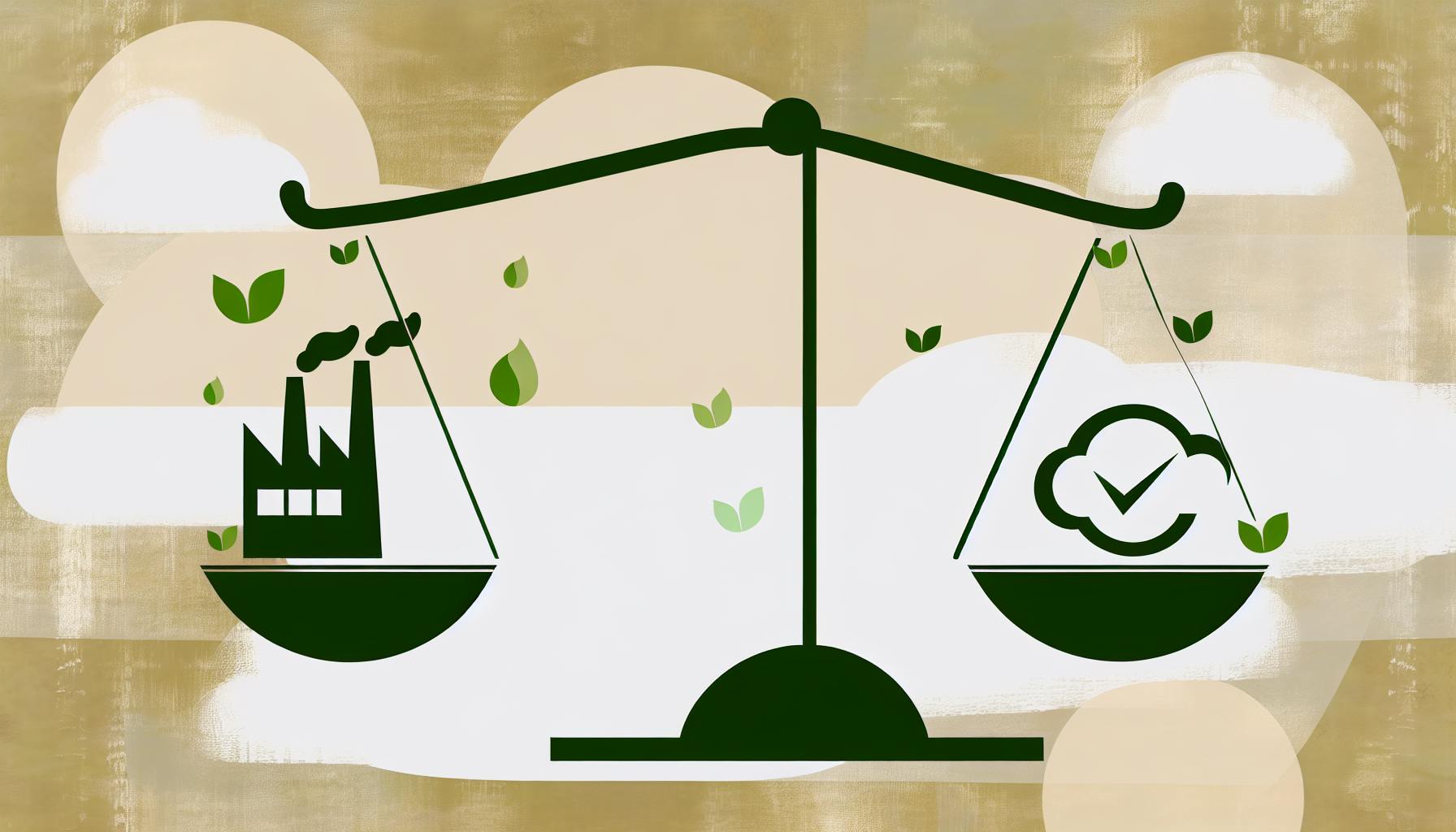Tracking scope 3 emissions can seem daunting for SMEs, but it's becoming increasingly important.
This straightforward guide breaks down the key steps for SMEs to implement the GHG Protocol's scope 3 standard into their sustainability efforts.
You'll get an overview of scope 3 emissions, learn practical tips for data collection and inventory management, and see real examples of SMEs putting these guidelines into action.
Scope 3 GHG Protocol Explained for SMEs
Understanding the Importance of Scope 3 Emissions
Scope 3 emissions refer to indirect greenhouse gas emissions from sources not owned or controlled by a company, but related to its operations and value chain. This includes emissions from purchased goods/services, transportation, waste disposal, employee commuting, investments, and more.
Though Scope 3 emissions are not required by most regulations, measuring and reporting them demonstrates a commitment to comprehensive carbon accounting and emissions reduction. With Scope 3 often making up the majority of an organization's carbon footprint, addressing them is key for limiting global temperature rise.
For small and medium enterprises, focusing on Scope 3 can uncover cost and emissions saving opportunities in their supply chain and operations. It also allows for more accurate tracking and reporting to stakeholders.
Overcoming the Complexities: A Guide for SMEs
Implementing the Scope 3 GHG Protocol can be daunting for SMEs without dedicated sustainability teams. From collecting supplier data to calculating emissions, it involves tackling many complex requirements.
To simplify the process, SMEs can leverage carbon accounting software to automatically compile emissions data. Starting with a few key Scope 3 categories makes calculation more manageable initially. SMEs can also collaborate with vendors/partners to obtain emissions data more easily.
With the right strategies, SMEs can reap the benefits of understanding Scope 3, supporting global climate action while gaining efficiencies and competitive advantage. Tracking these emissions allows for more impactful business decisions and sustainability communications.
What is scope 3 of GHG Protocol?
Scope 3 emissions refer to all indirect greenhouse gas emissions that occur across a company's value chain, excluding scope 2 emissions. The GHG Protocol Corporate Value Chain (Scope 3) Standard provides guidance on how to measure and report these emissions.
Some key things to know about scope 3 emissions:
-
They include both upstream and downstream activities - for example, emissions from raw material production, transportation, product use, and disposal.
-
They represent the majority of an organization's carbon footprint in most cases.
-
Reporting scope 3 emissions provides a more complete view of a company's climate impact.
-
Calculating scope 3 emissions can be more complex due to limited data availability and influence over external operations.
The GHG Protocol defines 15 categories of scope 3 activities. Some examples include:
- Purchased goods & services
- Business travel
- Transportation & distribution
- Processing of sold products
- Use of sold products
- End-of-life treatment of sold products
Simplifying the measurement and reporting of scope 3 emissions enables companies, especially SMEs, to better understand the broader climate impact of their business activities. This supports more informed target-setting and decision making on emission reduction strategies across the value chain.
How to calculate Scope 3 GHG emissions?
Calculating Scope 3 GHG emissions can seem daunting, but breaking it down into simple steps makes it more manageable for SMEs.
The key to remember is:
Scope 1 + Scope 2 + Scope 3 = Total GHG Emissions
There are two main methods for calculating Scope 3 emissions:
Spend-Based Method
The spend-based method involves using your organization's spend data across various categories like purchased goods, transportation, waste, etc. and multiplying it by appropriate emissions factors to estimate emissions.
The formula is:
Spend ($, €, £) * Emission Factor = Spend-Based Scope 3
For example, if you spent $100,000 on air travel last year, you would multiply it by the emissions factor for air travel to get the carbon footprint.
Activity-Based Method
In the activity-based approach, you track activity metrics like kWh of electricity, liters of fuel, kg of waste disposed, etc. and multiply them by emissions factors.
The formula is:
Activity Metric * Emission Factor = Activity-Based Scope 3
So if you used 10,000 kWh of electricity from the grid, you would multiply that by the grid emissions factor to calculate emissions.
Supplier & Outsourced Activity Method
For emissions from outsourced operations, processes or transportation, track supplier-specific activity data and emissions factors.
The formula is:
Supplier * Activity * Emission Factor = Supplier Scope 3
For example, multiply units shipped by your 3PL by emissions per shipment.
While Scope 3 can be intricate, these fundamental methods empower SMEs to reasonably estimate and report their value chain emissions. Automated carbon accounting software like ecohedge.com">EcoHedge further simplifies the process.
What is the scope 3 benchmark?
The Scope 3 Maturity Benchmark is a tool created by Proxima and the Scope 3 Peer Group to help companies measure and reduce their scope 3 greenhouse gas (GHG) emissions across their value chains.
Scope 3 emissions refer to indirect GHG emissions that occur across a company's upstream and downstream activities. This includes emissions from purchased goods and services, transportation and distribution, investments, employee commuting, waste disposal, and other areas.
Measuring scope 3 emissions is complex, but important for achieving net-zero targets. The Scope 3 Maturity Benchmark provides a systemic framework for organizations to:
- Assess their current scope 3 measurement and management capabilities
- Identify gaps and areas for improvement
- Develop roadmaps to drive progress on scope 3 emissions reductions
Key features of the Scope 3 Maturity Benchmark include:
- Assessment of scope 3 capabilities across governance, data, target-setting, supplier engagement and value chain decarbonization
- Scoring system to benchmark progress over time
- Customized improvement recommendations based on assessment results
By leveraging the Scope 3 Maturity Benchmark, companies can more effectively tackle their value chain emissions, contribute to climate goals, and build leadership in sustainable business practices.
What is the SBTi scope 3 standard?
The SBTi (Science Based Targets initiative) scope 3 standard refers to the emissions reporting requirements set out under the SBTi's Net-Zero Standard. Scope 3 emissions are all indirect emissions across a company's entire value chain, from purchased goods to transportation to product use and disposal.
Under the SBTi Net-Zero Standard, companies must set science-based targets for their scope 3 emissions in order to achieve net-zero emissions by 2050. Specifically, the SBTi requires companies to:
- Measure their scope 3 inventory according to the GHG Protocol Scope 3 Standard
- Set a science-based target covering at least two-thirds of total scope 3 emissions
- Have their targets validated by the SBTi
Setting scope 3 targets can be complex due to the diffuse nature of supply chain emissions. However, guidance and resources are available such as the GHG Protocol Scope 3 Standard, which provides requirements and guidance for companies calculating and reporting scope 3 emissions.
In summary, the SBTi scope 3 standard aims to accelerate corporate climate action by requiring science-based scope 3 goals as part of overall emissions reduction strategies on the path to net-zero by 2050. Understanding these requirements is key for companies looking to set ambitious decarbonization targets across their value chain.
sbb-itb-919600f
Foundations of the Scope 3 Standard for SMEs
The Scope 3 Standard provides a framework for companies to account for value chain emissions that occur as a result of their business activities. For small and medium-sized enterprises (SMEs), adopting this standard can seem daunting, but breaking it down into simple steps makes the process more manageable.
Defining Organizational Boundaries for Scope 3 Reporting
The first step is to define the boundaries of what parts of your company's operations will be included in Scope 3 emissions calculations. This involves determining which entities you own or control, and which activities contribute to your products or services. Setting precise boundaries makes data collection and reporting more accurate.
For example, an SME may decide to only include emissions from key suppliers and exclude small office equipment vendors. You can refine boundaries over time as data collection improves.
GHG Protocol Scope 3 Categories: An Overview
The Scope 3 Standard defines 15 emissions categories covering upstream and downstream activities. For SMEs starting out, it's best to focus only on the most relevant categories based on your sector, size, and influence.
Prioritizing categories reduces inventory costs and still captures the largest share of emissions. For example, purchased goods and product end-of-life impacts may dominate for manufacturers, while business travel is negligible.
Developing an Actionable Scope 3 Inventory Plan
With boundaries and priority categories defined, SMEs can create an inventory plan to track emissions over time. Begin by gathering base year data through supplier engagement and industry benchmarks to estimate a baseline.
Set realistic reduction targets for 2-3 focus areas first. Then expand data accuracy and coverage as your capabilities increase. Getting started is what matters most, even with imperfect information. Adjustments can be made annually as better data becomes available.
Mapping and Calculating Scope 3 Emissions
Collecting accurate and comprehensive data is crucial for SMEs looking to measure and reduce their Scope 3 emissions in line with the GHG Protocol. This involves working closely with suppliers, logistics partners, and other value chain actors to map emissions sources and collect activity data.
Collecting Data for Purchased Goods and Services
The first step is to categorize your purchased goods and services according to the Scope 3 standard. Prioritize collecting data from suppliers with the highest spend and emissions impact. Useful data points include:
- Materials contained in purchased products and their country of origin
- Weight of shipped products and mode of transport
- Percentage breakdown of renewable energy used by suppliers
Leverage existing procurement data and sustainability reports wherever possible. For suppliers lacking emissions data, estimate based on industry benchmarks.
Assessing Emissions from Transportation and Distribution
Work with your logistics and distribution partners to capture granular data on:
- Weight and volume of goods transported or distributed
- Actual transport modes and vehicle types used
- Distance travelled for each shipment
Compare various shipping options using delivery route mapping tools. Identify opportunities to optimize logistics for lower emissions.
Estimating Waste-Generated Emissions
Audit your operations and track all waste streams. Collect data on:
- Waste type, weight and volume
- Waste treatment and disposal methods
- Percentage of waste that is recycled
Use emissions factors specific to each disposal method to calculate waste-related emissions. Prioritize reductions in waste volume, increased recycling, and diversion from landfills.
Accurately quantifying Scope 3 emissions streamlines carbon reduction strategies and strengthens sustainability reporting to stakeholders. Leverage data collection tools and calculate emissions following the Scope 3 guidance. Reach out for tailor-made technical support.
Best Practices in Scope 3 Inventory Management
Scope 3 emissions refer to indirect greenhouse gas emissions across a company's entire value chain. Developing an accurate and robust Scope 3 emissions inventory is crucial for effectively monitoring, reporting on, and reducing carbon impacts. This requires establishing rigorous data tracking processes and maintaining inventory integrity through continual improvements.
Establishing Robust Data Collection Systems
To facilitate regular Scope 3 calculations, companies should implement data tracking systems that source emissions factors and activity data consistently. This includes agreeing on calculation methodologies, using automated data collection where possible, establishing processes to handle missing data, and continually expanding inventory boundaries as feasible. Maintaining detailed records of data sources, assumptions and exclusions also enhances inventory transparency and accuracy over time.
Ensuring Data Quality through Recalculations and Audits
Over time, updates to emissions factors, improvements in data access and changes to business activities can impact Scope 3 calculations significantly. Companies should plan to recalculate their baseline emissions inventory periodically to account for such changes. Conducting quality checks through third-party audits at least once every few years provides assurance on conformance to GHG accounting standards and inventory completeness. This drives continual enhancements in reported emissions numbers.
Engagement and Collaboration with Supply Chain Partners
Upstream and downstream emissions often comprise over 80% of total Scope 3 emissions for many companies. Engaging suppliers to provide accurate activity data by educating them on Scope 3 reporting is crucial. Implementing supplier scorecards and introducing contract clauses that mandate sustainability disclosures can drive better supply chain data availability. Knowledge sharing and collaborative target setting with value chain partners also enables deeper Scope 3 emissions reductions across sectors.
Using Scope 3 Inventory Data to Drive Change
Scope 3 emissions refer to greenhouse gas emissions that occur in a company's value chain but are not directly controlled by the company. These indirect emissions often make up the majority of an organization's carbon footprint. By measuring Scope 3 emissions, companies can gain valuable insights to inform sustainability strategies and credibly communicate progress with stakeholders.
Adopting Science-Based Targets Using Scope 3 Data
Comprehensive Scope 3 data allows companies to set emissions reductions targets grounded in climate science. The Science Based Targets initiative (SBTi) enables organizations to define goals aligned with the Paris Agreement for limiting global warming. When Scope 3 is included, targets consider the full footprint picture, spurring innovations across the value chain. Robust data aids in modeling different reduction scenarios to plot the most impactful and feasible decarbonization pathway.
Enhancing Transparency in Sustainability Reporting
Detailed Scope 3 disclosure builds trust and accountability with investors and customers. Reporting emissions across all relevant categories provides a complete view of environmental impact. This transparency enables stakeholders to clearly understand sustainability priorities and performance. Strong data also helps identify hot spots for communication efforts, like progress cutting supply chain emissions.
Uncovering Opportunities for Emission Reduction
A careful analysis of Scope 3 data reveals the activities and partners representing the best opportunities to drive down emissions. Companies can collaborate with carbon-intensive suppliers to implement cleaner solutions or source from low-carbon alternatives. There may also be potential to engage customers on greener consumption choices through incentives or education programs informed by granular emissions insights.
Scope 3 GHG Protocol Technical Guidance in Practice
The GHG Protocol Scope 3 standard provides comprehensive guidance for calculating greenhouse gas emissions across an organization's value chain. However, putting this complex methodology into practice can be challenging, especially for small and medium-sized enterprises (SMEs) with limited resources.
Real-world examples of SMEs successfully implementing Scope 3 can provide invaluable insights into practical strategies and lessons learned.
Scope 3 GHG Protocol Example: SMEs in Action
Several SMEs have managed to accurately measure and report their Scope 3 emissions by taking a phased, collaborative approach:
-
Prioritize the most relevant indirect emissions categories based on the company's operations and goals. Attempting complete coverage of all 15 categories at once is impractical for most SMEs.
-
Partner with key suppliers and customers to obtain activity data for the highest-impact categories. Many are willing to share data to support shared decarbonization efforts.
-
Leverage industry averages or secondary data sources to estimate emissions where primary data is unavailable. While less precise, this provides a reasonable starting point.
-
Automate data collection and carbon accounting processes over time. This reduces the reporting burden and enables more sophisticated Scope 3 management.
With targeted focus and pragmatic use of available data, SMEs can overcome resource constraints and still account for the majority of value chain impacts.
Navigating Challenges: Lessons Learned from SMEs
SMEs frequently encounter difficulties in Scope 3 measurement and reporting. By learning from each other's experiences, practical solutions emerge:
-
Data Availability: Develop data sharing agreements and collect sustainability data in supplier contracts. Seek industry participation to expand sector-specific datasets.
-
Calculation Complexity: Use emission factor repositories and online carbon calculators to streamline quantification. Focus on material sources instead of exhaustive completeness.
-
Limited Personnel: Assign responsibility to individuals in procurement, logistics, or sustainability. Explore student interns or shared service arrangements to secure extra support.
-
Stakeholder Engagement: Communicate the mutual benefits of transparency around Scope 3. Frame action on indirect emissions as smart risk management rather than just environmental stewardship.
With pragmatic assessment of capabilities and targeted capacity building over time, SMEs can navigate the challenges and unlock the opportunities of a robust Scope 3 program.
Conclusion: Embracing Scope 3 for Strategic Advantage
Scope 3 emissions make up a significant portion of most organizations' carbon footprints. By measuring and reporting these indirect emissions, companies can gain greater visibility into risks, opportunities, and environmental impacts across their value chains.
For small and medium-sized enterprises (SMEs), navigating the detailed Scope 3 Greenhouse Gas (GHG) Protocol can seem daunting. However, taking a simplified approach focused on the most relevant emissions categories can help SMEs overcome barriers to action.
Key Takeaways on the Scope 3 Journey
- Prioritize the Scope 3 categories with the highest emissions and business relevance. Collecting perfect data should not get in the way of making progress.
- Leverage existing sustainability initiatives and digitization efforts to efficiently gather Scope 3 data. Collaboration across functions and with partners is key.
- View Scope 3 tracking as an ongoing journey of incremental improvement, not a single project. Evolve strategies as capabilities and data availability increases over time.
Moving Forward with Confidence
Armed with a practical understanding of Scope 3 requirements, SMEs can implement targeted emissions strategies, unlock sustainability opportunities, strengthen stakeholder relationships, and future-proof business resilience. Streamlined and automated solutions enable companies to embed Scope 3 accounting into operations for continuous advancement on their net zero journeys.



.png)


